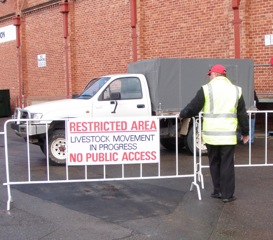 Humans will almost always come off second best when struck by a vehicle or piece of mobile plant. Being struck by moving plant and vehicles is a top priority of Australia’s regulators as they deal with the consequences of the horrific injuries.
Humans will almost always come off second best when struck by a vehicle or piece of mobile plant. Being struck by moving plant and vehicles is a top priority of Australia’s regulators as they deal with the consequences of the horrific injuries.
Here we discusses 7 key critical management actions you can take to prevent traffic accidents, including site roads arrangements, traffic signs, speed limits, parking facilities, pedestrian crossings, management of visitors, control of noise and emissions, and accidents.
1. Implement roads safety measures
Roads and their traffic management arrangements should be designed by qualified personnel (e.g. civil engineers) in accordance with sound design principles.
Traffic signs used for your site roads must be in accordance with the appropriate part of Australian Standard AS 1742. Safety signs should be used at least for:
- speed limits;
- sharp bends;
- junctions;
- pedestrian crossings;
- vehicle crossings;
- blind corners;
- steep gradients;
- road works; and
- any other specific site hazard.
Speed limits should be imposed throughout your site, as appropriate (e.g. 5 - 20 km per hour). Measures should be in place to ensure adherence to your site speed limits (e.g. speed humps, training, instructions, signage and observations of driver performance).
2. Consider parking bays and pedestrian crossings
Parking facilities should be designed and constructed in accordance with Australian standard AS 2890. Parking facilities for persons with disabilities should also be provided, as appropriate.
Marked and sign-posted pedestrian crossings should be located where required. In addition, safety barriers, in accordance with Australian Standard AS 3845, should be installed where required.
3. Install sufficient lighting
Roads, parking areas, pedestrian crossings, and other areas where vehicles operate, should be appropriately lit and designed to avoid extremes of light variation (i.e. moving from a brightly lit area to a dark one).
4. Look out for your visitors – they’re not from around here!
Drivers of delivery vehicles (couriers, trucks, tankers, vans, etc) and visitors who are permitted to enter your site with their vehicle, should be informed of the site traffic rules, as part of their site induction, before they are allowed to enter the site.
5. Control on-site refuelling
On-site refuelling of vehicles (including on construction sites and temporary sites) must be carried out only in designated and properly signed stations. Where possible, these areas should be bunded to prevent spills.
Precautions for on-site refuelling and/or fuel transfer, should include the following:
- Use of electrical earth straps, clips, etc to prevent static charges building up and causing a spark
- Specific instructions for towing fuel trailers over rough terrain;
- Specific instructions for keeping valves closed and vents open;
- An assessment of the trailer to determine whether it will cause a spill if it rolls over;
- Spill control equipment of the appropriate type and in sufficient quantities, as required on each site.
Where applicable, fuel-dispensing equipment should be in accordance with Australian standard AS/NZS 2229.
The arrangements of the following Australian standards should be utilised in the development of specific site procedures, as applicable:
AS/NZS 1020 for arrangements related to the control of undesirable static Electricity
AS 1940-2004 for arrangements related to the storage and handling of flammable and combustible liquids
AS 2809 for arrangements related to road tank vehicles for dangerous goods
AS 4979-2008 for arrangements related to precautions against electrostatic ignition during tank vehicle loading
6. Control noise and emissions
Arrangements should be in place to ensure compliance, in relation to vehicles on site, with regulatory arrangements related to air pollution and noise.
7. Investigate incidents
Any vehicle incident on site, whether resulting in injury or not, should be immediately reported and investigated.


